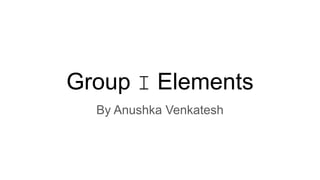
Group i elements
- 1. Group I Elements By Anushka Venkatesh
- 2. 1. Group 1 elements called alkali metals as their hydroxides are strongly alkaline. 2. General electronic configuration-ns1 3. Francium is highly radioactive. 4. Na,K abundant.Li,Rb,Cs less abundant
- 3. Physical Properties Periodic trends depend on- 1.nuclear charge 2. Screening effect Why does reactivity increase down the group? 1. Atomic radii- largest in respective period. Increases down the group i.e Li<Na<K<Rb<Cs 2. Ionization Enthalpy- M(g) M+(g) + e- HIE lowest in respective period Decreases down the group. 3. Hydration Enthalpy- M+(S) M+(AQ) Proportional to charge/radius ratio. The magnitude of hydration enthalpy decreases down a group. Li salts are always hydrated as it has maximum degree of hydration enthalpy.
- 4. Reason behind flame tests- Heat excites electron to higher energy level,electron emits radiation while returning to ground state. How would E value change across a period? 4. Melting and boiling points- decrease down the group. 5. Density- Li<Na>K<Rb<Cs 6.Appearance- the alkali metals are silvery white,soft and light metals. 7.Flame test- Alkali metals and their salts impart characteristic colour to an oxidizing flame and can be detected by their respective flame tests. 8. Standard Electrode Potential- measure of reducing power of element. Magnitude decreases down the group .
- 5. Chemical Properties 1. Reaction with air- Metal + dioxygen(from air) Metal Oxide [ Li reacts with N2 to form Li3N as well. Alkali metals are Stored in kerosene because of their high reactivity towards air and water.] Metal Oxide + vapour(from air) Metal Hydroxide Li-oxide Characteristics of alkali metal oxides- Na-peroxide 1.superoxide(O2-) and peroxide are larger anions than oxide ion.Hence larger Cations form peroxides and superoxides as they are more stable.[ fajans law] K,Rb,Cs-superoxides 2.oxide,peroxide=colourless.superoxide=yellow/orange.
- 6. 2. Reaction with water- 2M +2 H2O 2 M+ + 2 OH- + H2 Aqueous metal hydroxide [here M is reducing H2O] Despite having the highest E value, Li reacts less vigorously with water due to- 1. Its small size high ionization enthalpy 2. High hydration energy. Characteristics of alkali metal hydroxides- 1.They are strongest of all bases. 2.They are white crystalline solids.
- 7. 3. Reaction with Dihydrogen 2M + H2 2(M+)(H-) METAL HYDRIDE T=673K except for Li which reacts at 1073K Reason: Lithium’s small size makes it less reactive than the other alkali metals.
- 8. 4. Reaction with Halogens 2M + X2 2(M+)(X-) METAL HALIDE 1.Li halides are somewhat covalent due to Li’s polarising power. [ polarisation=Distortion of electron cloud of anion by the cation] 2. As Iodine is the largest halogen, LiI is the most covalent metal halide Characteristics of metal halides- 1.Enthalpy of formation decreases down the group for chlorides,bromides and iodides but increases down the group for fluorides. 2.Enthalpy of formation for fluorides>chlorides>bromides>iodides due to increase in size down the group. 3.Solubility of (M+)(X-) decreases down a group as hydration energy decreases and lattice energy increases(except flourides).. 4.LiF has low solubility due to high lattice energy and CsI has low solubility due to low hydration enthalpy.
- 9. 5. Reducing Nature M(s) M(g) sublimation energy H1 M(g) M+(g) ionization enthalpy H2 M +(g) M+(aq) hydration enthalpy H3 Lesser the value of [ H1+H2+H3] better the reducing agent. High degree of hydration enthalpy makes lithium a strong reducing agent.
- 10. 6.Solutions in Liquid Ammonia 1. M + NH3 (M(NH3))+ + (e(NH3))- Ammoniated ion - imparts blue colour to solution 2. M + NH3 MNH2 + ½ H2 [M is reducing NH3] 3. In concentrated solution ( excess of M) , the blue colour changes to bronze colour.
- 11. 7. Alkali metal salts of oxoacids Oxoacids - acidic proton is on a hydroxyl group with an oxo group attached to the same atom i.e the (OH) and (O) is attached to the same atom. Eg:H2SO4,H2CO3,HNO3,H3PO4 etc. 1. M + H2CO3 M2CO3 + 2 H+ [ M REDUCES H2C03] 2. M + H2CO3 MHCO3 + H+ 1.These salts are soluble in water and are thermally stable. 2. Stability of the metal carbonates and bicarbonates increase down a the group . Reason: increase in electropositivity down the group. 3. Boiling point and melting point is directly proportional to the ionic character of the salt. Hence, LiHCO3 does not exist as solid under normal conditions. Li2CO3 is not stable to heat, it polarises (CO3)2- ion as follows- Li2CO3 Li2O + CO2
- 12. Anomalous properties of Lithium Difference between Li and alkali metals- 1. It’s high B.P and M.P makes it harder than other metals. 2. It’s least reactive, strongest reducing agent and its forms monoxide and reacts with atmospheric nitrogen. 3. It’s deliquescent [ all these properties are due to its small size and high polarising 4. LiHCO3 isn't formed in solid state. ability] 5. Does not form ethynide when reacted with ethyne. Similarity between Li and Mg- 1. Equal charge/radius ratio and ionic size. [ Li has a charge of 1 and Mg of 2 and their radii are similar, 2. They react slowly with water and react with nitrogen. Then how is charge/ radius ratio same?] 3. Their chlorides are soluble in organic solvents. 4. Both are deliquescent.